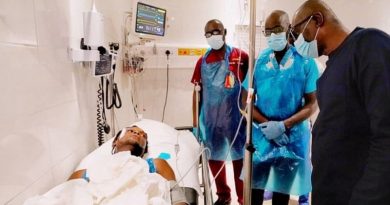Why have women had to tolerate painful coil fittings?
When Molly*, 29, went to get the copper coil, her doctor said that in a previous fitting, they had ruptured a patient’s uterus wall. “They assured me that it had only happened once and it was years ago, but that legally they had to disclose it,” she recalls. “ I was a bit taken aback but decided to go through with the appointment.” Molly had been on hormonal contraception for 10 years. The copper coil had been recommended to her as a suitable alternative. But the fitting did not go well.
“It was so painful that I almost passed out,” she says, recalling how the nurse helped her to regain control of her breathing for several minutes afterwards. “It felt like I was being stabbed in the womb. Even now, the thought of it makes me feel sick. If I had known that the pain would have been even a fraction of what I felt, I would have run a mile.”
Molly’s story is not unusual. Since the weekend, hundreds of women have been sharing similarly traumatic experiences on social media after Caitlin Moran argued in a piece forThe Times that everyone deserves pain relief when having an IUD fitted. “Why is it presumed that women will be fine with having their cervix artificially dilated with a pair of metal barbecue tongs before having what is basically the wire coat hanger from a doll’s house inserted into their uterus?” she asked.
Moran’s call to action was swiftly followed by BBC broadcaster Naga Munchetty, who said she screamed so loudly during her coil fitting, that her husband tried to find out which room she was in to make the procedure stop.
Difficulties with contraception are just one of the many things women must accept as a fundamental part of their lives. Today, the NHS lists 14 different types – eight of which are hormonal – ranging from the pill to the implant. The only non-surgical contraceptive available to men is the condom and, 60 years since the pill became available to women in the UK, the world still awaits a male equivalent.
The coil was developed in 1909 by the German physician Richard Richter and now comes in two forms: the intrauterine device (IUD) and the intrauterine system (IUS). The former (also known as the copper coil) is one of the few non-hormonal contraceptives available and works by releasing copper into the womb which thickens the cervical mucus and makes it more difficult for sperm to reach an egg and survive; the latter works by releasing the hormone progestogen which also prevents the sperm from entering the uterus. Both are small, T-shaped devices that are then inserted into the womb by a doctor or nurse. Depending on which type you choose, the coil can last anywhere between three and 10 years before it needs replacing.
Data regarding contraceptive usage in the UK is scarce, however, NHS research has found that long-acting reversible forms of contraception (such as the coil) have been steadily increasing in popularity in the last decade, with 10 per cent of women using IUS coils in 2018/29, while eight per cent had IUDs. The popularity of the coil is largely down to the fact that, when inserted correctly, it requires no maintenance and is more than 99 per cent effective.
I had a major panic attack on the table because I was so scared of the pain
Lily*, 37
That said, like with all contraception, whether or not you have a positive experience with the coil depends on how your body responds to it. The NHS website states that having a coil fitted “can be uncomfortable” and advises taking painkillers if necessary. However, in the stories that have been shared online, women report experiencing everything from severe pain to fainting, while others claim the procedure took 20 minutes or longer (the NHS states it should take no longer than five).
Lauren*, 40, was told the copper coil would help her manage the heavy periods she had been experiencing throughout her 20s – she also had a history with hormone fluctuation, hence why she was recommended to use a non-hormonal contraceptive. “I went to have it fitted at my local hospital, but midway through the procedure, I passed out due to some sort of reaction in my cervix. I was then referred to have to have it inserted under general anaesthetic, which went fine.”
Several months later, however, Lauren was experiencing severe pain and non-stop bleeding. “I decided to have it removed, but the doctor who did the procedure was very rough with me, and when I said I felt like I was going to faint, they told me that if I found this hard, I’d have ‘no chance’ with childbirth’.” Alex*, 42, was met with similar disdain when she went into shock while having a hormonal coil fitted. “I was offered Panadol and essentially told that I just needed to suck it up.”
The way in which women’s health concerns are dismissed in this way taps into a wider pain bias that has been uncovered in recent years, with various studies showing how women are less likely to be taken seriously when reporting concerns. One study, for example, found that women in the emergency department who report acute pain are less likely to be given effective painkillers, while another found that women are less likely to be taken seriously in emergency departments.
“My first coil was fitted by my male GP with a female member of staff present,” says Lily*, 37. “I had a major panic attack on the table because I was so scared of the pain.” When she needed her coil to be replaced, Lily requested a female doctor do the procedure. “It was much more gentle and I felt far more comfortable,” she recalls. “My GP just seemed so impatient during the previous procedure. I got the impression he didn’t really get why it would cause discomfort.”
Pain aside, coil fittings can lead to psychological discomfort as well, particularly for sexual assault survivors, for whom the proceadure might be a “trauma trigger”. “A traumatised nervous system is constantly scanning the environment for danger, anything that reminds us of past trauma, so that the body can protect itself by going into fight, flight or freeze mode,” explains Olivia James, Harley Street trauma specialist. “So an invasive procedure, like getting a coil fitted, can remind the nervous system of a sexual assault.”
Billie*, 27, had an emergency IUD fitted after being raped – they can be fitted up to five days after unprotected sex and are 99 per cent effective at preventing unwanted pregnancies. “It was horrific,” she recalls. “I wasn’t told what type it was or what side effects to expect, either, which made the whole thing even more horrendous.”
Regardless of whether you are a sexual assault survivor or not, there is often a lot of emotion surrounding coil fittings, says Dr Deborah Lee, sexual health and reproductive specialist. “It involves a vaginal examination, and insertion of gynaecological instruments into the vagina and then into the uterine cavity. For many women, they have not had any of this done before and it can be a nasty shock.”
It’s not always possible to predict who will have a bad coil fitting and who won’t
Dr Deborah Lee, sexual health and reproductive specialist
The key to assuaging fears is to ensure that the patient is fully informed of everything that is going to happen during the procedure, adds Dr Lee, who conducts counselling sessions with her clients before fitting them with coils. “This should be detailed and unhurried,” she says. “It includes looking at pictures, holding a coil in her hand, and taking a leaflet home afterwards. The patient should have every opportunity to ask questions.”
Despite the swathes of negative experiences circulating on social media, many women have had positive experiences with coils. According to The Lowdown, the world’s first review platform for contraception, IUDs and IUSs have the highest overall satisfaction rating. “We are very cautious of putting women off having the coil,” the company states. “Our data shows that once it’s fitted, 54-61 per cent of women report having either a “very good” or “excellent” experience, which is over double the proportion that state for the combined or mini pill.
Commenting on the stories being shared online, Dr Diana Mansour, vice president of the Faculty of Sexual and Reproductive Healthcare (FSRH) tells The Independent: “It saddens me to read these reports. No woman should endure severe pain when having their IUD fitted. I offer pain relief before and, where necessary, during an IUD placement including the use of local anaesthesia. I let women know that they are in control during the procedure and at any point additional pain relief can be given or other options explored such as having the IUD fitted under conscious sedation or general anaesthesia in the local hospital. Ultimately, I want to support women to choose a contraceptive which best suits them” The FSRH added that it will be sharing updated clinical guidance on coils to ensure women experience the highest standards of care when it comes to fittings.
The Lowdown is calling for clearer and stronger guidance on the insertion procedure to ensure that women have all of the information they need in order to ensure they feel comfortable. “For years, we’ve been telling women about the wonders of sprays, gels and other painkiller options and trying to educate them so they can ask for these things during their appointment.” The Lowdown’s data also found that, out of all of the other forms of contraception available, both hormonal and non-hormonal coils had the lowest impact on emotions and moods. It also had the lowest effect on sex drive.
“It’s not always possible to predict who will have a bad coil fitting and who won’t,” says Dr Lee. “But once the patient knows all these facts about what the procedure will involve and what pain relief is available to them, she will feel more in control. She also needs to know that if she changes her mind at any point, the fitting will be discontinued.”
*Names have been changed
You can find out more about contraception by visiting the NHS website here






